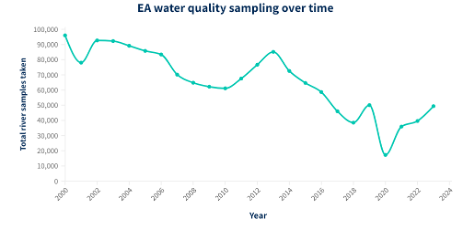How Healthy Is Your River? – talk by Keir Smith from West Sussex Rivers Trust
At ERA’s October 2025 talk Keir began with an overview of the rivers trust and of the dire state of our rivers, telling us that just 15% of rivers in England are in good ecological health and that since 1970 freshwater species have seen an 83% decline globally, that being faster than any other habitat.
Our own River Rother has its own list of issues:
· High sediment load leading to it sometimes resembling the chocolate river in Willy Wonka
· 92 non-native species, some invasive!
· Moderate Ecological & Fish Status in 2019…downgraded to Poor Status in 2022. Poor Chemical Status in 2019 & ‘Does Not Require Assessment in 2022’
· 61% of Rother catchment is used for grazing or crops, grazing often allowing stock access into the river, damaging the banks leading to further sedimentation
· Many impoundments eg weirs
· Absent species eg Water Voles, Beavers
A major issue for all our rivers is pollution which can come from so many sources: Agriculture (Sediment & Fertiliser); Combined Sewer Overflows (CSOs); Land Management (Septic Tanks & various spraying); Road Runoff (Heavy metals, petrol, rubber, microplastics etc); Private Outfalls (Misconnected pipes); Pharmaceuticals; Industrial Waste; and Dog Flea & Tick Treatments (Insecticide).
Although nitrogen and phosphorus are vital for life, unhealthy concentrations become detrimental to the health of the river. Phosphates can come from: Urine (from untreated sewage from Wastewater Treatment Works or poorly managed septic tanks); Fertiliser; Detergents & Soaps (look for low phosphate options such as Faith in Nature, Bio-D, Smol, Method, Ecover etc.); Tap Water.
So, what is WSRT doing about all this?
• Natural Flood Management to improve our Chalk Stream Resilience.
• Soil Health Monitoring and working with farmers.
• Raising awareness on importance of river ecosystems.
• Creating wildlife corridors for nature.
• Supporting our citizen scientists and volunteers to get involved in protecting and enhancing river systems
• Leading the Rother Partnership!
Keir heads up the River Guardians project for WSRT, which is a whole catchment project involving citizen scientists who monitor river health through chemical testing (Phosphate, Nitrate, Turbidity, Temperature & Dissolved Solids) plus observations of Wildlife & Ecosystems, Pollution and River Characteristics. Comparing this work to that of the EA, Keir told us that in 2022 the EA had surveyed the river at 38 sites whereas in 2024 the River Guardians completed tests at 150 sites. In summary, the over 170 River Guardians have carried out 1800+ surveys, made 30 pollution incidents reports and are monitoring 29 out of the 34 waterbodies within the combined Rother Arun catchment. And this at a time when the EA is water sampling less and less - see chart:
Based on their results a range of scorecards have been produced which summarise these results for different areas and which are available to download from the WSRT website.
Keir gave an example of test results from Buriton which showed phosphate levels that were off the scale. Subsequent investigation by the EA and Southern Water discovered that there was a manhole overflowing with foul sewage due to a blockage. The situation was swiftly remedied but might have persisted for much longer had the local river guardian not identified that there was a problem.
It is predicated that climate change will impact on Water Quality, Water Quantity, River Ecology and River Communities.
This all matters particularly in the Rother valley because much of the Rother includes chalk-fed streams which rely on consistent groundwater recharge. A mismatch in rainfall timing affects aquifer replenishment, reducing baseflow in summer when it's needed most. Chalk Streams are one the world’s rarest freshwater habitats there being only 200 globally with 85% of them being in England! They contain a mix of extremely sensitive species that enjoy the ‘goldilocks zone’ of temperature and flow that Chalk Streams provide making them something of ‘canaries’ of ecosystem change/loss.
River Guardian (Spring 2025) data shows rivers across Sussex & Hampshire have experienced record nitrate, phosphate, and temperature spikes, threatening aquatic life. These trends are directly linked to higher temperatures and reduced dilution capacity in rivers.
There are no quick solutions, as we know, but Initiatives such as River Guardians & Riverfly monitoring provide vital data and evidence to push action. Further to this we need to re-meander our rivers, create wetlands, restore floodplains (e.g., re-introduce beavers and other measure to "Slow the Flow"). Greater use can be made 0f Sustainable Urban Drainage Systems (SuDS), such as permeable pavements, green roofs, and swales to absorb rainfall. We can reduce Water Demand by actions such as increasing metering, and providing more waterwise education. An holistic river catchment planning approach will lead to managing land and water together.
And what could we all do as individuals?
· Consider you behaviours/water use and those around you.
Make yourself heard to your MP.
Register as a WSRT Volunteer – wsrt.org.uk/get-involved/volunteer-with-us
Walk your local streams… love your river!
Survey for Invasive Non-Native Species, Water Quality, Riverfly, Dry rivers and join in with ERA Balsam pulling events.
Come along to WSRT film nights and webinars to learn more!


